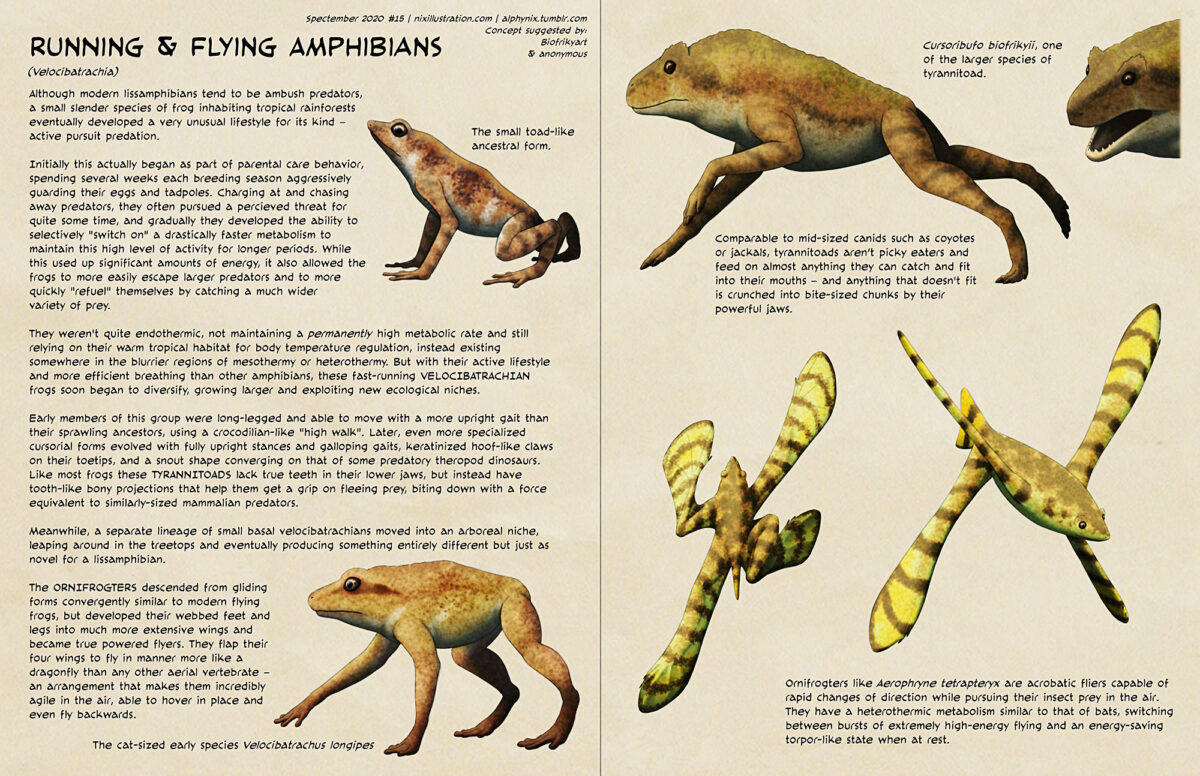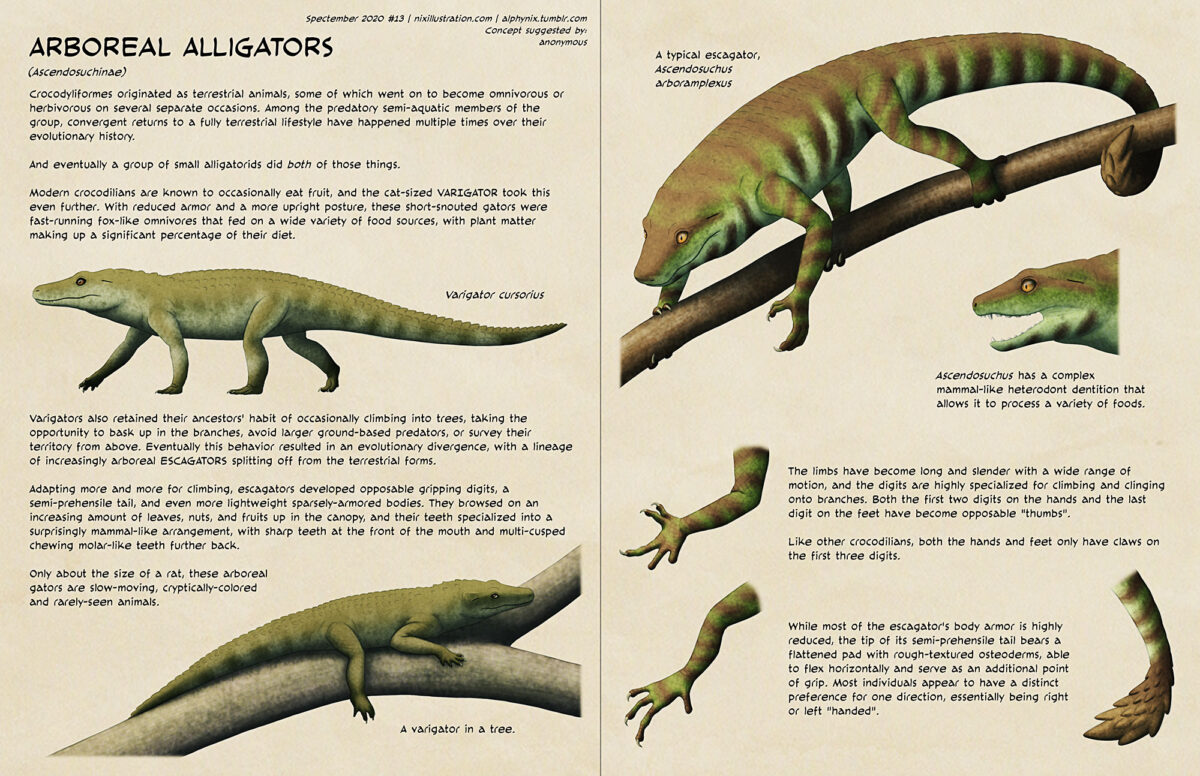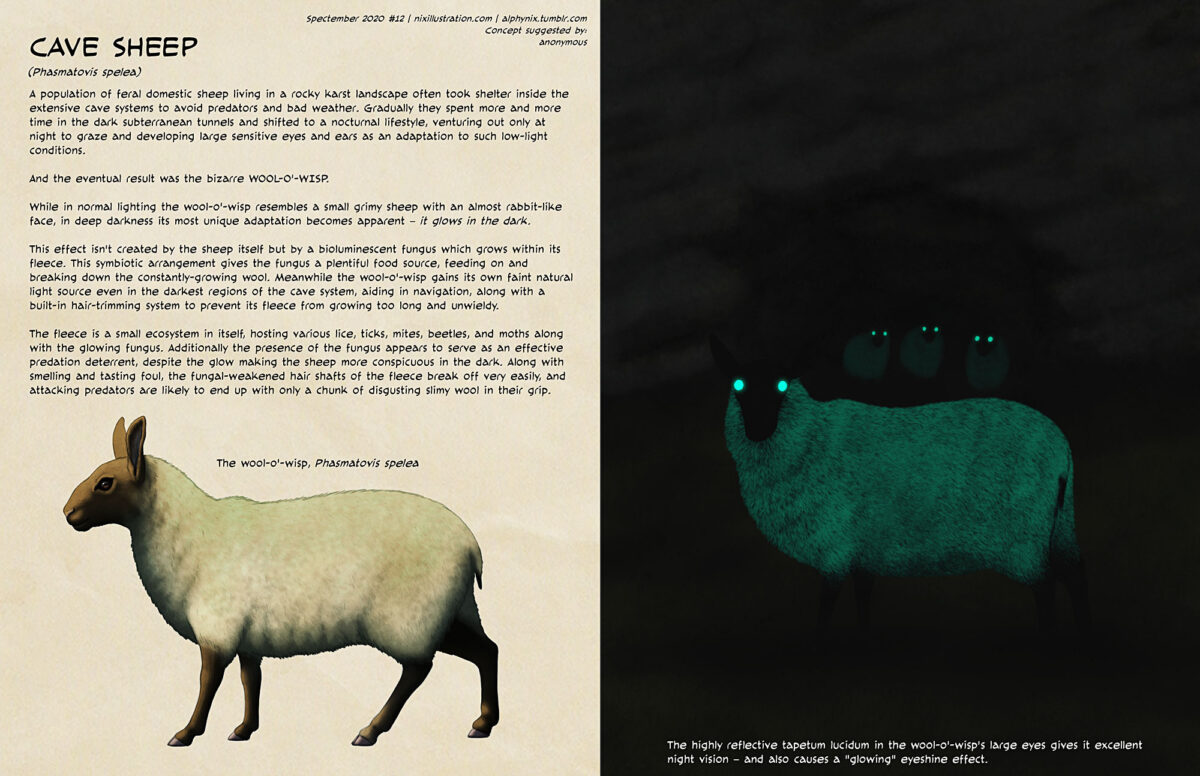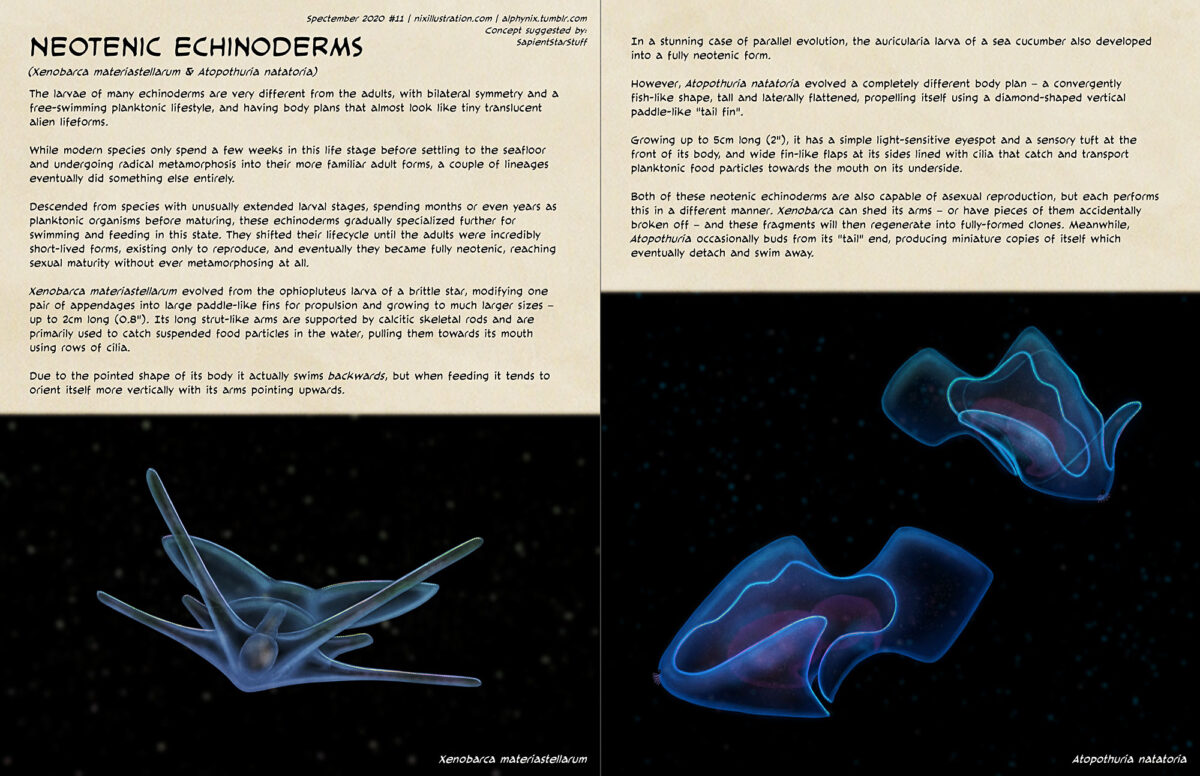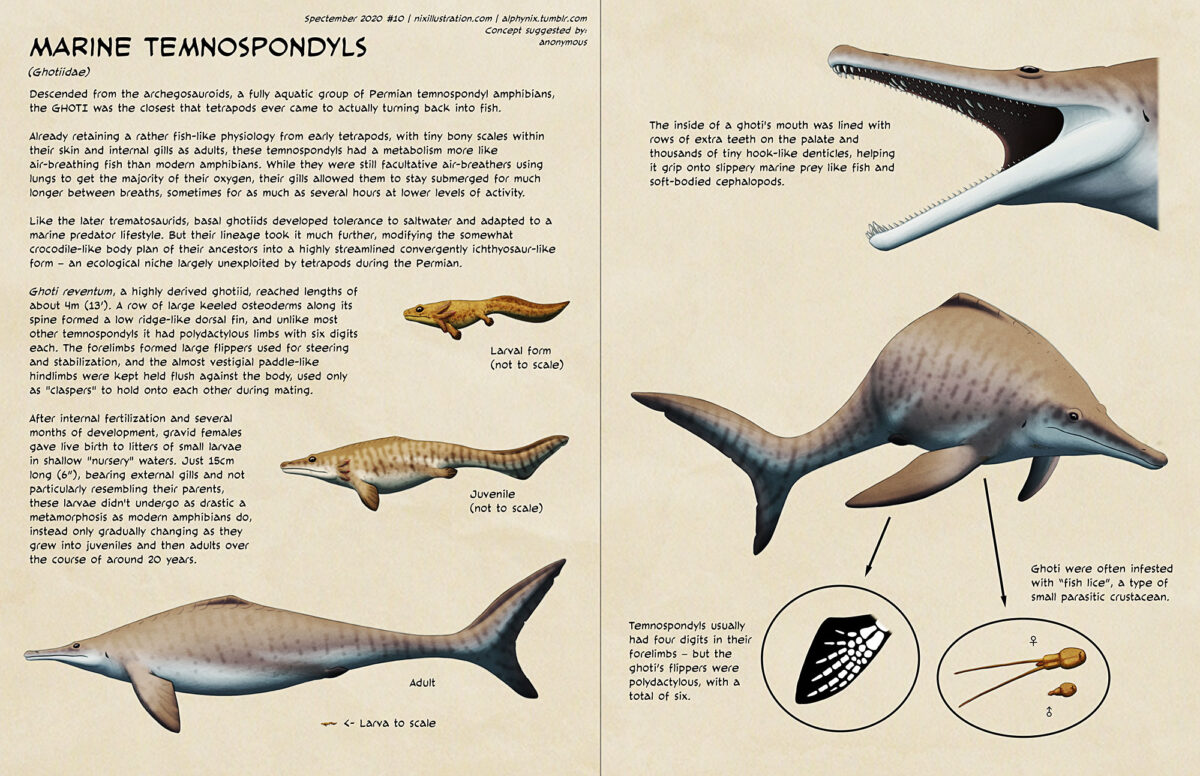Transcript for the text on the image under the cut:
Continue reading “Spectember #15: Running & Flying Amphibians”Category: spectember
Spectember Interlude: All Yestermorrows
C. M. Kösemen, also known as “Nemo Ramjet” or “Memo”, is a Turkish artist and researcher known for his paleoart, photography, surreal and sometimes Gigeresque imagery, and speculative evolution work.
His 2006 book All Tomorrows explores a speculative future in a similar manner to Last and First Men and Man After Man. While often haunting and strange, and occasionally silly or oddly touching, potential readers of All Tomorrows should be aware of possibly disturbing content, since it does contain some nudity and body horror along with plot elements of eugenics, xenophobia, religious fanaticism, and repeated genocides.
Beginning close to our own present day, the story covers many millions of years of evolution and genetic engineering, all framed as the “best guess” reconstructed history of humanity as assembled by a paleoanthropologist living a billion years from now.
It starts off fairly tame, with minor anatomical divergences in Martian colonists, a war for planetary independence, and the development of a genetically engineered spacefaring subspecies of human – but then things start to get weird. What is initially believed to be a complete lack of other intelligent life in the Milky Way is thrown into question by the discovery of a fossil of an unmistakably Earth-based lifeform on a distant alien world – hinting at the existence of an incredibly ancient and powerful civilization, capable of transplanting and genetically modifying species for unknown purposes.
…A civilization which eventually revisits the human-colonized galaxy, and proves to be intensely hostile. In the aftermath of this devastating first contact, posthuman survivors evolve and rediscover each other, fight more wars, contact other aliens, and even return to the long-lost Earth.
In 2008 Kösemen completed his most well-known speculative evolution project – Snaiad, a huge worldbuilding endeavor that depicts the natural history of an alien planet.
A world much older than the Earth, the planet Snaiad experienced multiple cataclysmic mass extinctions over its eight billion years of evolutionary history, essentially “resetting” complex life a few times. While there are a couple of enigmatic hints in the fossil record of what may have been past civilizations, the fauna at the time of human colonization contains no sapient species.
The main branch of Snaiadi life catalogued in the project are the highly diverse “vertebrates“, which are superficially convergent with Earth tetrapods – but their internal skeletons are hydrocarbon-based, and their four legs are formed from the fusion of eight ancestral limbs. Their primary muscles are hydraulic, evolved from the water vascular system of a sea cucumber-like ancestor, and function based on pushing rather than pulling. What appears to be a “head’ is actually a genital stalk sporting pseudo-jaws often used for food processing, while phallic-looking structures growing from the creatures’ chests contain their true heads and mouths.
An updated version of Snaiad is currently in development, with the goal to eventually publish it in book form.
Kösemen was also a co-author of the 2012 book All Yesterdays, along with Darren Naish and John Conway. Arguing that much of conventional paleoart was outdated, overly conservative, shrink-wrapped, and inaccurate compared to our understanding of animal anatomy and behavior, All Yesterdays mainly explored speculative-but-plausible reconstructions of prehistoric life – and was incredibly influential on modern paleoart, being a major part of the ongoing “second dinosaur renaissance”.
The free “sequel” e-book All Your Yesterdays in 2013 collected together images from many other artists, and featured even more paleontological speculation. Notably one of its entries accurately predicted a later discovery – the speculative filter-feeding “Bearded Ceticaris” by John Meszaros turned out to have had a real-life analogue in the form of Tamisocaris borealis.
2013 also saw the publication of Cryptozoologicon, again a collaboration between Kösemen, Naish, and Conway. Applying speculative biology to various cryptids, this book reviews the evidence for each featured creature and then presents a playful reconstruction of their possible identity and evolutionary history.
Next week: bird is the word.
Spectember Interlude: The Modern Dinosaur Explosion
(Darren Naish over on TetZoo has already done much more extensive coverage on this subject. Check out his series of posts here: part 1 – part 2 – part 3)
The concept of long-extinct prehistoric animals surviving into modern times has been around since at least the mid-1800s, with Jules Verne’s 1864 novel Journey to the Center of the Earth being one of the earliest well-known examples. Many many other pieces of media have since explored the concept, especially with the ever-popular non-avian dinosaurs, but often the depictions were of ancient relict stock species virtually unchanged after millions of years.
Two things in the 1980s began to change this idea, however. Obviously Dixon’s The New Dinosaurs in 1988 was a major influence – but there was also the infamous dinosauroid.
Emerging from some rather exaggerated ideas in the 1970s about the level of intelligence of relatively “big brained” troodontids, the dinosauroid started as a “thought experiment” in a 1982 article by paleontologist Dale Russell and taxidermist Ron Séguin. Unfortunately the resulting creature was heavily anthropomorphized, and while every element of its anatomy was justified as being the “best” evolutionary solution for a big-brained bipedal creature there was obviously a lot of human-centric unconscious bias in its design.
But it was wildly popularized in media at the time, and incarnations of it have regularly appeared in dinosaur-based pop culture ever since. (And it’s also unfortunately become intertwined with antisemitic conspiracy theories, often being used as a visual representation of “lizard people”.) Many other hypothetical sapient dinosaurs have appeared in various works over the years, usually also derived from maniraptoran theropods – although exceptions like Star Trek‘s hadrosaur-descended Voth do also exist.
But getting back to non-sapient dinosaurs… let’s talk about The Speculative Dinosaur Project!
Also known as “Specworld” or just “Spec” for short, this was an absolutely massive collaborative online worldbuilding project in the same vein as The New Dinosaurs – a world where the K-Pg asteroid impact never happened, there was no mass extinction, and non-avian dinosaurs continued to dominate global ecosystems.
Started by a July 2001 thread on the Dinosaur Mailing List, Specworld quickly branched off into its own dedicated website. The main contributors and project runners were Daniel Bensen, David Marjanović, Brian Choo, and Mette Aumala, but there was a huge list of other names involved over the years, and many of them went on to become professional paleontologists, biologists, writers, and illustrators.
(Additional contributors included Tim Morris, Clayton Bell, Brett Booth, João Boto, Steve Brusatte, Stacey Burgess, Martin Chavez, Morgan Churchill, Anthony Docimo, Michael Habib, Michael Hanson, Daniel R. Heald, Jonas Holjer, Emile Marc Moacdieh, David Namen, Eric Christopher Ømtvedt, Donald Ridenbaugh, Edgar Segovia, Ville Sinkkonen, Chris Srnka, and Raymond Tobin.)
Presented as the observations of scientists studying a parallel-reality version of Earth, full of the results of 66 million years of divergent evolution, Specworld developed a huge variety of speculative species and ecosystems.
Both avian and non-avian dinosaurs were abundantly represented (as would be expected in something called The Speculative Dinosaur Project!), with creations such as arboreal ornithopods, spiny theropods, huge grazing sail-backed sauropods, ant-eating noasaurs, and the disgusting “dire rhea” and “rectal probe”. But groups other than dinosaurs were also given a fair amount of attention, including butt-gilled turtles, ankylosaur-like crocodiles, whale-like squid, burrowing sea cucumbers, skunk-like geckos, bone-crushing platypuses, gliding multituberculates, cookiecutter tadpoles, symbiotic spiders, and terrifyingly toxic plants.
At one point there were plans to eventually publish all this as a physical book, but it never came to fruition.
Specworld’s progress began to stall around 2005 or so when Daniel Bensen stepped down from the main editor role, unable to devote enough time to it while in college. Others continued developing Spec for several years afterwards, making revisions to fit in with newer paleontological discoveries that had made some elements of the world outdated, but the original website was abandoned in late 2008 and discussion was moved to a Yahoo Group — which then shut down in 2019 with the closure of that service.
Most of Spec’s content is still around, but currently everything seems to be a bit fragmented. Parts are archived on the Speculative Evolution wiki, along with a Russian site featuring a saved English version, and much of the old site can still also be viewed on the Internet Archive Wayback Machine.
Tomorrow: All Yestermorrows and some more aliens.
Spectember #14: Land Sharks
(I will probably do more with these pipe-necked weirdos at a later date.)
Transcript for the text on the image under the cut:
Continue reading “Spectember #14: Land Sharks”Spectember #13: Arboreal Alligators
Transcript for the text on the image under the cut:
Continue reading “Spectember #13: Arboreal Alligators”Spectember #12: Cave Sheep
Transcript for the text on the image under the cut:
Continue reading “Spectember #12: Cave Sheep”Spectember #11: Neotenic Echinoderms
Transcript for the text on the image under the cut:
Continue reading “Spectember #11: Neotenic Echinoderms”Spectember #10: Marine Temnospondyls
Transcript for the text on the image under the cut:
Continue reading “Spectember #10: Marine Temnospondyls”Spectember Interlude: The Worlds of Wayne Barlowe
The After Man trilogy and The Future Is Wild might be the most well-known Earth-based works of speculative evolution, but for extraterrestrial life one of the most famous names is the American artist Wayne Douglas Barlowe.
Starting off illustrating the covers of science fiction novels, his first major project was Barlowe’s Guide to Extraterrestrials in 1979. Depicting alien species from various works of sci-fi in the format of a biological field guide, attempting to make them all look like real believable lifeforms, this book was a huge success at the time and eventually had a fantasy-themed sequel in 1996, Barlowe’s Guide to Fantasy.
But it was his 1990 book Expedition that helped define the alien side of the modern speculative evolution movement. Presented as a collection of field notes, journal entries, and paintings in his distinctive style, it chronicles a human crew’s visit to the planet Darwin IV in the year 2358, encountering a wide variety of strange organisms and trying to avoid having any lasting impact on the natural environment of this sometimes deadly planet. Some parts of the Darwinian species’ anatomy resembles Earth tetrapods, taking particular inspiration from the 20th century “alien prehistoric world” trope, but other elements are very different – all the animals appear to lack eyes, mostly sensing their surroundings using sonar and infrared receptor pits, there are no true jaws but instead various hollow proboscis “tongues”, there are flying forms using biological jet propulsion, and some species reach absolutely gigantic sizes compared to Earth life.
Expedition was adapted into a television documentary titled Alien Planet in 2005. Originally conceived as a nature film with little to no narration, the final product was more of a dramatization interspersed with interviews with various scientists and sci-fi filmmakers. Instead of a human presence on the planet, here the biological surveying is performed by autonomous drone-like probes with basic artificial intelligence.
Barlowe has also been involved in concept art for films, television shows, and videogames, with spec-evo relevant projects including the early design work for the creatures of Pandora in James Cameron’s Avatar, and the Barsoomian inhabitants of Mars in John Carter.
After being long out of print, a new edition of Expedition is due out this year (2020) from Echo Point Books: https://www.echopointbooks.com/art/expedition
Next week: more speculative dinosaurs!
Spectember Interlude: Mr. Dixon’s Wild Ride
The rhinogrades were the start of larger-scale speculative evolution works, but what truly popularized the genre to the general public are undoubtedly the works of Scottish geologist Dougal Dixon.
His 1981 book After Man was a “zoology of the future” using over a hundred speculative species to demonstrate the principles of evolution. Set 50 million years from now in the world of the Posthomic period, humans are long gone and the hardy survivors of a prior mass extinction have diversified and convergently evolved to fill vacant ecological niches, including rabbits becoming ungulate-like animals, penguins becoming giant whale-like creatures, and rats taking on the role of canid-like predators.
Some of the more outlandish creations have become infamous over the years and may seem cliché by modern standards – like the giant flightless predator bats – but when it was first published it was revolutionary, and there’s still a certain charm to it all even if the artwork isn’t quite as good as it could have been. Despite Dixon himself being a talented artist, the publisher chose to have all the final images created by other illustrators based on the original concepts. (And the updated 2018 edition goes as far as replacing a couple of images that the author was especially unhappy with.)
The success of After Man led to two “sequels” a few years later. In 1988 The New Dinosaurs took the premise of the K-Pg mass extinction never happening and used “an alternative evolution” to explain the geographical distribution of species. Inspired by the dinosaur renaissance, some of its fictional creations arguably predicted later paleontological discoveries – many species are depicted as extensively fuzzy (including ornithischians!) and aren’t too terribly shrinkwrapped for the time, and there are then-unknown concepts like small arboreal climbing theropods, giraffe-like ground pterosaurs, and semi-aquatic beaver-like mammals coexisting alongside the dinosaurs.
But at the same time much of it just hasn’t aged very well, with a lot of the paleontological basis of the The New Dinosaurs having become horrendously outdated over the last thirty years. Many of the species are also rather lumpy-looking and unappealing, and some are just direct stand-ins for recent mammals. For example, Australia is home to both kangaroo-like and koala-like dinosaurs for no apparent reason other than Australia just being Like That, and South America features very specific anteater, manatee, glyptodont, and sabertooth predator analogues.
Then came Man After Man in 1990. Initially intended to be a direct sequel to After Man, Dixon’s original concept would have shown the impact of humans arriving in the Posthomic period, escaping their dying overpopulated civilization by time-traveling into the far future and promptly causing ecological devastation and a mass extinction all over again.
But that was not to be.
Instead the publisher pushed Man After Man in a very different direction, and it became an “anthropology of the future” chronicling the evolution of post-human species genetically engineered to adapt to climate change. Rather grotesque and full of dystopian nightmare fuel, even Dixon himself has called it “a disaster of a project”.
(It also suffers from what may be plagiarism, with some of the designs looking worryingly close to those of another project that had been pitched several years previously by Wayne Barlowe. It remains unclear how much involvement and control Dixon actually had with Man After Man after the drastic change in concept, or whether he was even aware of this similarity.)
Some of Dixon’s works became especially popular in Japan, with After Man being adapted into both a stop-motion documentary and an animated short, and even having merchandise, and a manga version of The New Dinosaurs.
Later Dixon was a consultant and creature designer on the 2002 documentary series The Future Is Wild, a sort of “spiritual successor” to After Man – although due to the rights to After Man being held by Dreamworks at the time, none of his previous creations could be used. Depicting various ecosystems 5 million, 100 million, and 200 million years in the future, this series featured memorable speculative species such as whale-like gannets, giant carnivorous bats, sauropod-sized tortoises, four-winged birds, aerial fish, and arboreal squid.
The Future Is Wild was also adapted into both a manga and a Canadian-produced animated children’s series. There were plans over the years for a sequel documentary series, a feature film version, and then more recently a full reboot (including that VR game with the questionably-designed titan dolphin), but all seem to have succumbed to development hell.
Eventually Dixon’s original premise for Man After Man was reworked into Greenworld in 2010 (so far only ever published in Japanese), using his own artwork and changing the setting to an Earth-like exoplanet populated by animals descended from radially-symmetrical starfish-like ancestors. A generation ship carrying thousands of humans fleeing a devastated Earth arrive and colonize the planet – and over the next few centuries repeat history by exploiting the native lifeforms and putting Greenworld through multiple ecological catastrophes, causing a mass extinction that leaves the entire biosphere in ruins.
At some point another project called Microplatia was also developed for a planned exhibition on alien life at the Science Museum in London, but due to sponsorship issues was never completed.
Tomorrow: an expedition to a different alien world.

